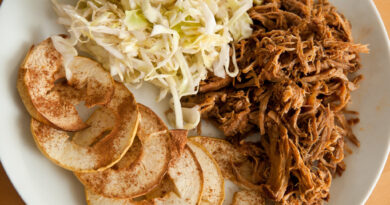Alloco
Alloco: West Africa’s Golden Treasure
Introduction
Alloco, a popular West African dish, is a delicious treat made from fried plantains, seasoned to perfection, and often served with a variety of sides. Its simplicity belies its cultural significance, as it represents much more than just food. Alloco is a cherished street food, a family favorite, and a symbol of culinary tradition across many West African countries, particularly Côte d’Ivoire, where it is believed to have originated.
In this blog article, we will delve deep into the world of Alloco. From its history and cultural roots to the specific preparation techniques and its variations across different regions, this guide will give you a comprehensive understanding of why Alloco holds such a special place in the hearts of West Africans and beyond. We’ll also explore its nutritional benefits, how it’s being reimagined in modern cuisine, and some creative ways to enjoy it at home.
What Is Alloco?
Alloco (also known as dodo in Nigeria, kelewele in Ghana, and makemba in Congo) is essentially fried ripe plantains. Plantains are starchy, less sweet relatives of bananas, and they are a staple food in many tropical regions. Alloco is typically made by cutting the plantains into thin slices or cubes, seasoning them with salt and sometimes spices, and deep-frying them until golden brown.
In Côte d’Ivoire, Alloco is commonly sold by street vendors, served as a snack or side dish, often with grilled fish or chicken and a spicy tomato-onion sauce. Its rich, caramelized flavor and crisp exterior make it a favorite across generations and social classes, from the streets of Abidjan to family dinner tables.
A Brief History of Alloco
Alloco’s origins can be traced to Côte d’Ivoire, though its appeal quickly spread across West Africa. The name “Alloco” is derived from the Baoulé language, spoken by one of the largest ethnic groups in the country. The dish’s widespread consumption began during the colonial period when plantains became more accessible as a cash crop. As street food culture developed in urban centers, Alloco became one of the most popular offerings due to its affordability, simplicity, and ability to be prepared quickly in large quantities.
However, Alloco isn’t confined to Côte d’Ivoire. In neighboring countries like Ghana and Nigeria, plantain-based dishes have been staples for centuries. In Ghana, a similar dish called kelewele is seasoned with a blend of spices such as ginger, garlic, and chili, giving it a distinct flavor profile. Meanwhile, in Nigeria, the fried plantains (called dodo) are usually less spicy and often served with jollof rice or beans.
The journey of Alloco from humble street food to a beloved culinary icon mirrors the broader cultural and economic shifts in West Africa. It reflects the ingenuity of local communities in transforming simple ingredients into mouth-watering delicacies, as well as the growing influence of African food on global culinary trends.
The Cultural Significance of Alloco
In West Africa, food is not just about sustenance—it is deeply connected to culture, community, and celebration. Alloco is no exception. In Côte d’Ivoire, the dish is a must-have at social gatherings, family celebrations, and festivals. It’s often served as an accompaniment to grilled meats and fish, forming part of the larger communal meals that are central to West African culture.
The role of women in the preparation and sale of Alloco also reflects the traditional gender roles in many West African societies. Alloco vendors, mostly women, are a familiar sight on the streets of Abidjan. These women, known as “allocomanes,” often fry up large batches of plantains on portable stoves, selling them to passersby for a small fee. Over time, they have become an integral part of the urban economy, contributing to the vibrancy of street food culture.
Alloco has also become a symbol of Ivorian national identity, celebrated for its simplicity, flavor, and widespread appeal. It is not uncommon to hear Ivorians talk about Alloco with a sense of pride, as it represents both their culinary heritage and the spirit of communal living.
How Alloco Is Made: Traditional Preparation Methods
While Alloco is a relatively simple dish, achieving the perfect texture and flavor requires some skill. The process begins with choosing the right plantains. The best plantains for Alloco are those that are fully ripe but not overripe. They should be yellow with black spots, which indicates that they are sweet and firm enough to hold their shape during frying.
Here’s a traditional method for preparing Alloco:
Ingredients:
- 3-4 ripe plantains (yellow with black spots)
- 1-2 cups of vegetable oil (for frying)
- Salt (to taste)
Optional seasonings (depending on regional variations):
- A pinch of chili powder
- Garlic (minced)
- Ginger (grated)
- Onion powder
Instructions:
- Peel and Slice the Plantains: Begin by peeling the plantains. This is done by making a shallow incision along the length of the plantain and then gently peeling off the skin. Once peeled, slice the plantains into rounds, cubes, or diagonal strips, depending on your preference.
- Season the Plantains: Season the plantains with salt. Some variations also include a pinch of chili powder or other spices, especially in Ghanaian kelewele, where the plantains are spiced with a mixture of ginger, garlic, and chili before frying.
- Heat the Oil: In a deep frying pan or pot, heat the vegetable oil over medium heat. Ensure the oil is hot enough by dropping a small piece of plantain into it—if it sizzles immediately, the oil is ready.
- Fry the Plantains: Fry the plantains in batches to avoid overcrowding the pan, which can cause uneven cooking. Fry them for about 2-4 minutes on each side, or until they are golden brown and crispy on the outside. The plantains should remain soft and tender inside.
- Drain and Serve: Once fried, remove the plantains from the oil and place them on a paper towel to drain excess oil. Serve immediately while they are still hot and crispy.
Serving Suggestions:
Alloco can be served on its own as a snack or as part of a larger meal. In Côte d’Ivoire, it is typically paired with a spicy tomato-onion sauce, grilled fish, chicken, or fried eggs. In Ghana, kelewele is often enjoyed with groundnuts (peanuts) for added texture and flavor. In Nigeria, fried plantains (dodo) are commonly served as a side dish with jollof rice, beans, or stews.
Nutritional Benefits of Alloco
Though Alloco is a fried dish, plantains offer a host of nutritional benefits that make this dish more than just a guilty pleasure. Plantains are an excellent source of complex carbohydrates, which provide sustained energy. They are also rich in dietary fiber, vitamins (especially vitamins A and C), and essential minerals like potassium and magnesium.
Here are some of the key nutritional benefits of plantains:
- Rich in Fiber: Plantains contain a significant amount of fiber, which aids in digestion and helps regulate blood sugar levels. This makes Alloco, when eaten in moderation, a satisfying and filling snack.
- Good Source of Vitamin A: Vitamin A is essential for maintaining healthy vision, immune function, and skin health. Ripe plantains are a great source of this important nutrient.
- High in Potassium: Potassium is crucial for heart health, helping to regulate blood pressure and support muscle function. Plantains are a potassium-rich food, making them beneficial for cardiovascular health.
- Natural Energy Boost: The complex carbohydrates in plantains provide a slow and steady release of energy, making Alloco a great snack for staying fueled throughout the day.
However, since Alloco is fried, it is important to enjoy it in moderation, as excessive consumption of fried foods can contribute to weight gain and other health issues. Opting for healthier oils, such as coconut or olive oil, can help reduce the health risks associated with frying.
Modern Takes on Alloco
In recent years, Alloco has started to make its way into contemporary culinary spaces, with chefs and food enthusiasts experimenting with different variations of the dish. From upscale restaurants to food trucks, Alloco is being reimagined in creative ways, showcasing its versatility and appeal.
Here are some modern takes on Alloco:
- Alloco Tacos: This fusion dish combines crispy fried plantains with fresh salsa, guacamole, and grilled chicken or fish, wrapped in a soft tortilla. It’s a delicious and innovative way to enjoy the flavors of Alloco with a modern twist.
- Alloco Salad: For a lighter option, try incorporating Alloco into a salad. Toss the fried plantains with mixed greens, avocado, tomatoes, and a tangy vinaigrette. The sweetness of the plantains adds a unique contrast to the fresh vegetables.
- Alloco and Plantain Chips: Instead of traditional fries or chips, serve your Alloco with crispy plantain chips for added crunch. This variation is great as an appetizer or a side dish for grilled meats or seafood.
- Alloco and Avocado Toast: For a trendy breakfast or brunch option, try serving Alloco with mashed avocado and whole-grain toast. The combination of flavors and textures is both satisfying and nutritious.
- Vegan and Gluten-Free Alloco Bowls: With the rise of plant-based diets, many foodies are incorporating Alloco into vegan bowls, pairing it with quinoa, roasted vegetables, and tahini sauce for a wholesome, balanced meal.
Conclusion: Alloco—A Timeless Dish with Endless Potential
Alloco, while simple in its ingredients and preparation, holds a special place in the culinary landscape of West Africa. It’s a dish that transcends borders, blending tradition with modernity and uniting communities through its delicious, golden-brown perfection. From the bustling streets of Abidjan to modern kitchens around the world, Alloco continues to evolve, adapting to contemporary tastes while staying true to its roots.
As West African cuisine gains more recognition globally, Alloco stands out as a symbol of the region’s rich culinary heritage. Whether enjoyed as a street snack, a side dish, or part of a creative new recipe, Alloco is a dish that is as versatile as it is delicious. Its sweet, savory, and crispy goodness ensures that it will remain a beloved favorite for generations to come.



